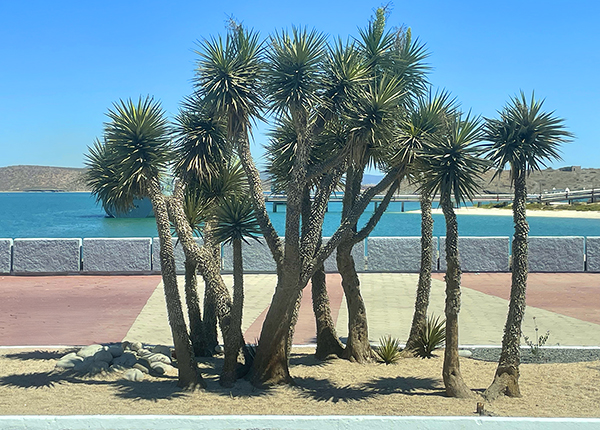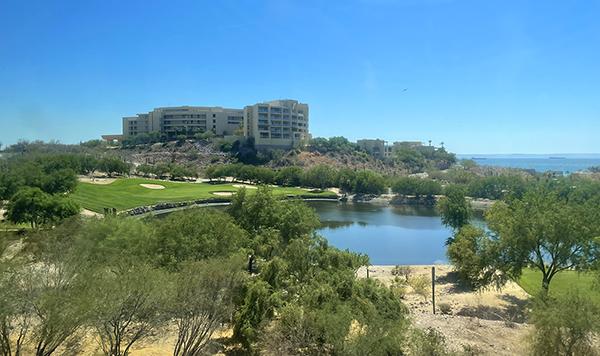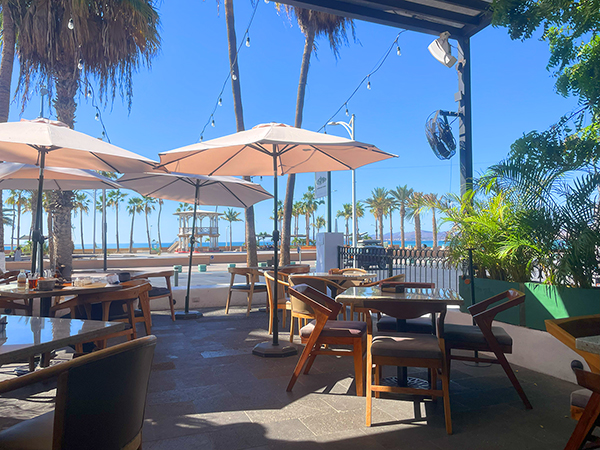

|
|
 |
 |
 |
 |
 |
|
May 21-22, 2025 Marti Eicholz Sailing on May the 20th from Topolobampo, Mexico to La Paz, Mexico, is the beginning of the last quarter moon, a time when the Milky Way is about to make its first big appearance this year in the Northern Hemisphere. Between May 20 and May 30, as The Odyssey sails far from city lights during the late-night and early-morning hours, between midnight and 5 a.m. when skies are dark and moonless, we will see the galaxy’s bright core, a band of light, stretching from horizon to horizon, a pale, white glow, the impressive arc of the Milky Way in Baja California, one of the top twenty places in the world for stargazing. Light pollution hides the Milky Way from most Americans, keeping them from seeing their home galaxy in all its beauty. How fortunate we are living and sailing on The Odyssey! La Paz is one of three coastal capitals in Mexico, located one hundred thirty-seven miles north of the southern tip of the Baja California peninsula, tucked between the Pacific Ocean to the west and overlooks a huge bay, the Sea of Cortez with beautiful white sand beaches to the east. It is home to the most populous in the state of Baja California Sur with a population of over 250,000. A fun fact about La Paz: La Paz, a center of business and industry, is the highest national capital in the world, lying more than 10,000 feet above sea level and most of La Paz is within a canyon. La Paz enjoys three hundred days of sunshine (dry most of the year) with an average temperature of 64 to 72 degrees Fahrenheit. The Baja California peninsula has been inhabited for over twelve thousand years by various populations, according to well-preserved cave paintings. The Conqueror, Hernan Cortes, organized the first trip by sending ships to these lands in 1533. In 1535, Hernan Cortes founded La Paz. The inhospitable nature of the area forced him to retreat. Pearl diving thrived in the region during the 16th and 17th centuries. Many efforts to colonize the area proved unsuccessful, until 1811. Jose Espinoza established the first permanent settlement. In 1830, La Paz became the capital. The name “La Paz” means “peace” in Spanish. The city possesses boundless natural resources and is a center for fishing and trade. La Paz has unique natural beauty, arid terrain, mountainous areas, mangroves, abundant fauna, and a rich marine biodiversity. La Paz, with its pristine landscapes, offers a blend of adventure, relaxation, and cultural experiences. Whether you're drawn to a vibrant city that is super charming and authentically Mexican with an interesting historic center and a stunning waterfront, or the beauty of the desert that can be explored by hiking, or beautiful beaches, marine animal encounters, or the unique marine life of the Sea of Cortez, often called “the world’s aquarium,” there is something for everyone. The town is sprawling and expanding but for my shipmates it is the small historic center, the ‘Port of Illusion’ and the stretch of seafront, the Malecon, that are of interest. Strolling along the vibrant waterfront Malecon with its wide sidewalk, tiny beaches, benches, and lots of ocean-themed sculptures, created by local artists, symbolizing La Paz, you are likely to hear French, Portuguese, Italian, English or Spanish, but this is the most ‘Mexican’ city in all of Baja. It’s an international town, a laid-back town with old-world beauty. Enjoy the 3.4 mile stretch from the Marina de la Paz in the south to Playa Coromuel in the north, meet friends, exercise or pause to simply enjoy the unimpeded dazzling colors that the sunset offers like seeing the marina, lit up orange and red. This is what you call, “The Magic of the Malecon.” This charming coastal city has some beautiful scenic beaches like El Coromuel and El Tesoro, known for white sand and crystal-clear calm waters with turquoise tones and mangrove areas. El Tesoro is a quiet, non-motorized watersports in a protected bay ringed with aquamarine shallow water, perfect for abundant fishing in the coves. La Paz is also a hub for marine life encounters: Experience legendary sport-fishing for marlin, tuna, or dorado. Snorkel with playful sea lions or whale-sharks during December through February, or scuba dive with hammerhead sharks and giant mantas. Go kayaking and spot dolphins, sea lions, turtles, gray whales, and gray sharks in the tranquil bays of Espiritu Santo Island, a protected marine park. Visit a natural paradise, Isla Espiritu Santo, just 15.5 miles from La Paz, near to the bay and the most beautiful island in the Sea of Cortez. The island is a protected natural marine park of incredible beauty and with a kingdom of biodiversity: the indigenous creatures include sea lions, dolphins, turtles, and at some times of the year, gray whales and gray sharks. The contrasts of the reddish color volcanic rocks, the turquoise blue sea and brilliant sunsets produce an exciting, extraordinary scene. It is made up of two main islands: Espíritu Santo and La Partida with three reefs and four rocky cliffs. You can explore by kayaking, snorkeling, diving with sea lions, or trekking between the pink rock canyons. North of La Paz, you will find the most beautiful beach, Playa Balandra, in an enclosed cove with calm, shallow azure water and unique landscape of this iconic beach. Kayak or paddleboard, explore tide pools, gaze upon Espiritu Santo, or hike to neighboring coves. Playa El Coromuel is further north along the coast, but sheltered inside its bay with shallow waters, stretching for miles. Playa El Tecolote, closest to Balandra, sits at the northern end of the peninsula with waves a little rougher. Playa El Saltito is east of the peninsula, not protected, the waves are strong, the scenery incredible, the beach quiet, and the drive through the mountains is stunning. An awesome thing to do is to swim with the whale shark and enjoy the grace and gentleness of the largest fish in the world (during the migration period of October to May). Whale sharks enjoy warm waters, feeding on plankton and allowing us to swim and observe up close their natural habitat. This good-natured giant represents no danger to humans; they are calm and friendly. They are in danger of extinction. This is happening because of the reduction of their populations due to legal and illegal fishing, other threats like garbage in the seas, accidents with boats and pollutants, resulting in a change in their habitat. Human behaviors can negatively affect an animal and its biology. The most sensible thing to do when interacting with a whale shark is to listen carefully to the instructions of certified guides. It is possible to have an enriching experience and have a safe one for the species. Visit the historic Cathedral of Our Lady of La Paz (a cathedral and minor basilica) in Murillo Square, built in 1835 with neoclassical architecture and Baroque elements and learn about the city’s religious history. Explore The La Paz Serpentarium, a unique reptile sanctuary with a selection of typical fauna of the region. Discover the colorful and vibrant street art murals in La Paz, Mexico. They represent the cultural origins of the town, as well as many simultaneous themes of the Indigenous people and their relationship with the sea. La Paz is a rainbow of art reflecting its environment, culture, and history. Street art is used as a tool to spark imagination, empower the disadvantaged, and encourage locals to take pride in their city and culture. The goal is to encourage people to re-appropriate public spaces, repainting it in their image. La Paz has a relationship with the sea, as did the ancestors and the locals do today. We on The Odyssey came to La Paz for its aquatic biodiversity, sundry cultures, and profound history. We are leaving La Paz with its starry skies and strong contrasts. A place where ancient cacti grow slowly in the deserts. A place where beautiful pristine sand beaches separate land and sea. A place of dreamy views we see in our dreams. La Paz, a port of comfort and quiet, a place of “peace,” characterized by tranquility, a perfect destination to start over, to start anew. The Odyssey sets sail with calm waters, embracing turquoise tones, nature, and a spectacular sunset.
|
|
Copyright © 2025 All rights reserved |